Ecopave hot-in-place asphalt recycling system
Advantages include cost savings of up to 50 percent, life cycle comparable to new HMA, reduced lane closure time and lower GHG emissions

The Ecopave Group, based in Kamloops, British Columbia, is a world leader in the manufacture of Hot-In-Place (HIP) asphalt paving systems. The system they developed has been used extensively in the province for over 25 years.
"Although the Hot-In-Place (HIP) process has many names and is carried out using many methods throughout the world, B.C.'s HIP process today is a unique pavement rehabilitation strategy that is intended to increase the pavement's service life by treating the top 50 mm of asphalt," according to a technical paper, British Columbia's Success with Hot-In-Place Recycling - a 25 year History, by Finlayson et al.
The development of the Ecopave HIP system
The idea for the Ecopave system originated in 1985. Al Rorison and Pat Wiley were operating a traditional paving company, Rorison-Wiley Blacktop in Williams Lake, in the interior of British Columbia, when they saw "a very crude version of what we do now," said Wiley. "We thought we could do better. So we approached the British Columbia government and said, ‘We want to build this and put it to work on your highways,' and they said, ‘Sure. If it works, we'll use it.' And that's what we did.
"Right from the beginning, the B.C. Ministry of Transportation (MOT) was open to doing something new but they wanted something better than the original technology. They said, ‘We like the concept but it needs a lot of improvements, including increasing the recycling depth from 25 mm to 50 mm and cleaning up the smoke emissions it produces.' We immediately went to work on it.
"Within about five years, we had created a new version of the technology that we patented. We developed what we call the multi-stage recycling process, which enabled us to go deeper, faster and cleaner. And we didn't stop there.
"It's been a process of continuous improvements over the years leading to what is fast becoming recognized as the world leading technology in this field. This claim is backed up by our extensive track record of producing successful high quality, cost effective and environmentally friendly recycled pavements on over 11,000 lane kilometres of B.C. highways."
According to Wiley, Ecopave invented Multi-Stage Hot-In-Place Asphalt Recycling (HIPAR) and are the only company in the world manufacturing the system. They not only manufacture the equipment at a state-of-the-art facility, they also use the equipment in their contracting division, ARC Asphalt Recycling.
"Operating the equipment ourselves provides a great vehicle for research and development," said Wiley. "Our guys in the field are a great source of new ideas, big and small, and they take great pride in their work." ARC, led by Superintendent Garth Parker, won the B.C. MOT paving contractor of the year award in 2008 and 2013 competing head to head against conventional paving methods, and they were finalists in 2012 and 2014.
As a further testimonial to Ecopave's stature in the province, their system is featured on the cover of the B.C. government's 2016 Standard Specifications for Highway Construction.
B.C. gets HIP
Finlayson et al. explain how B.C. took the initiative to recycle asphalt in the 1980s, well before greenhouse gases (GHG) were known to be a major problem.
In the early 1950s, B.C. had few paved highways, as did most of Canada. In less than 20 years, from the late 1950s to the early 1970s, most of B.C.'s provincial numbered highways were constructed and paved. As a result, many locations needed resurfacing at the same time. The use of HIP as a pavement treatment provided the government with a cost effective method that matched available resources.
The report notes that over the years, the B.C. MOT has played a key role in the development of HIP by "identifying candidate sites for HIP treatment, and creating specific work programs as well as studying those sites."
Moreover, it continues, "...for the first time the MOT has considered the repeated application of the HIP process at the same location. In the case of four project locations in the study sample, the MOT is proposing the ‘re-HIP' of the road section. The performance of the re-HIP recycled section will be of significant importance and will be reported on in a few years' time as these projects are just in the process of being implemented."
Ecopave's Multi-Stage HIPAR Process
"Earlier technologies could only achieve a recycling depth of 25 mm at a speed of about one kilometre per day. This was not deep enough to remove the cracks, ruts and potholes from the full of the top layer of pavement which is commonly 50 mm. So we developed the first technology that can achieve a full 50 mm (two inches)," said Wiley. And it does so at up to four kilomres per day one lane wide"
Ecopave's HIPAR system consists of five heavy-duty, self-propelled construction machines. The combined length of them is over 80 metres long and the combined weight is over 80 tons. They travel down the road together in a line and heat, remove, rejuvenate and re-lay the existing top 50 mm of the road surface, all in a single pass. None of the material is hauled away. One hundred percent of the existing material on the road, material that has already served for up to 20 years, is recycled.
The Preheater at the front of the line starts the heating process, using a 10-million BTU propane radiant heater.
This is followed by two or three Heater Miller units which heat and remove the pavement; each has a propane radiant heater rated at 10 million BTUs. The milled windrow is lifted over the next heater.
A rejuvenating agent to restore binder properties and up to 30 percent new HMA are added and blended in the 200-tph, twin-shaft pugmill. Both the Heater Millers and Pugmill Remixer are computer controlled.
The pavement is then laid with a conventional paver and compacted with rollers, producing a smooth, consistent pavement that is free from segregation.
Benefits of the Ecopave system
"The B.C. government has been collecting data on smoothness over the last seven years and, on average, our projects are smoother than conventional [paving]," Wiley said.
Finlayson et al. provide details in their report on a B.C. MOT HIPAR study which shows that the Ecopave system delivers cost savings of up to 50 percent compared to mill and fill, life cycles are comparable to new HMA, greenhouse gas is reduced by 30 to 40 percent, and lane closure time is reduced by up to 75 percent.
Wiley acknowledged that the closest competitor to what they do is mill and fill. "That's where they use cold grinding machines to grind off the top layer, generally 50 mm (two inches). Then they haul that material back to a central plant and combine it with about 80 percent new material.
"In our system, we use 80 percent recycled material and 20 percent new material and the reason is that we heat the pavement before we remove it so we're not crushing the stone and degrading the existing material. Conventional systems use the cold grinding systems that degrade the material, so they can't use as much of it in the final mix.
"By reducing the amount of new material that we need to purchase, the oil and the aggregates, we can reduce the cost because about half the cost of resurfacing a road is buying and transporting the new materials."
Wiley said that in cities, where there's a lot of manholes, short stretches and traffic, conventional cold milling and repaving still makes sense. "We like to use our big machines out on the open highway. That's the best market for us."
While Ecopave's system is mainly used on major highways, it is also used on roadways, such as recent paving done in Courtenay on Vancouver Island. It has also been used at airports.
In fact, Wiley said that they were the first to use Hot-In-Place Asphalt Recycling as the final riding surface for a commercial airport runway, the main runway at B.C.'s Kelowna International Airport in 2012. All specifications were met, the project was completed on time and on budget, and they saved the client over $3 million.
This is quite a testimonial on the quality of their work because an airport runway is the most difficult type of paving, Wiley said.
This year they did a smaller airport in Vernon. It was only one-kilometre long but very interesting, he added. "We did it in three days, which was really amazing...as airports like to reduce their downtime."
While Ecopave has sold machines in different parts of the world, the U.S., Mexico, Malaysia, Israel, Sweden and other countries, they have found that operating the machines is more profitable than selling them, so that has become their major focus.
"More recently, we've been lobbying other provinces in Canada to use it, and now the province of Ontario has adopted this technology and also the province of Alberta. So, starting next year, we'll be doing projects in Ontario and Alberta with our own machines."


